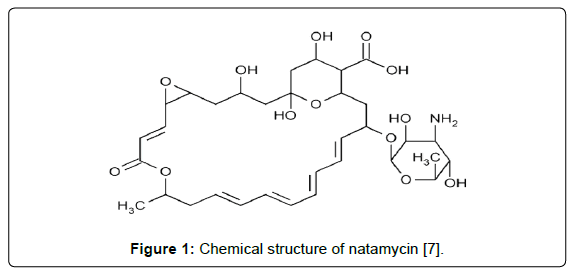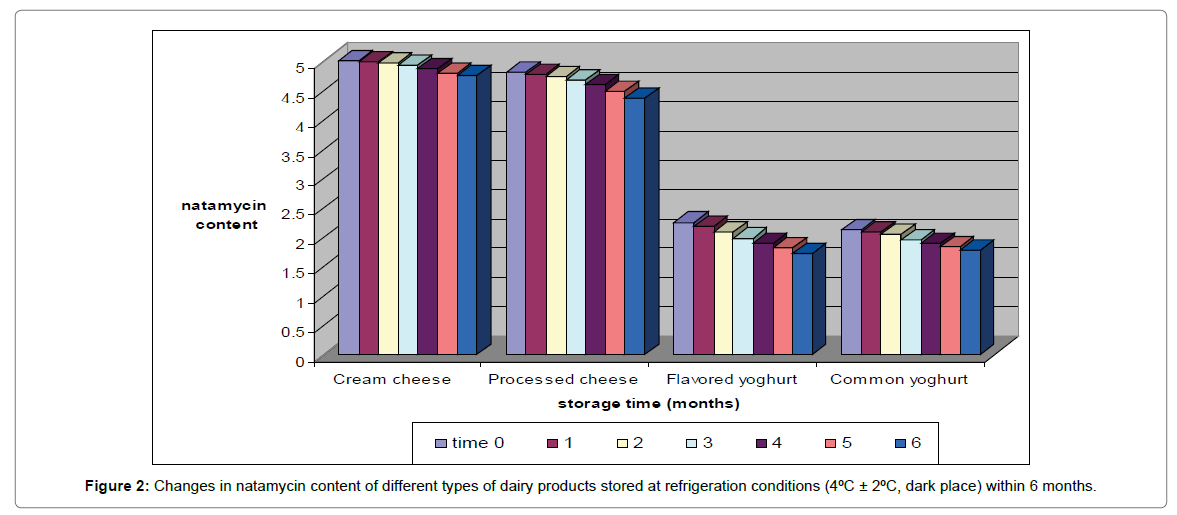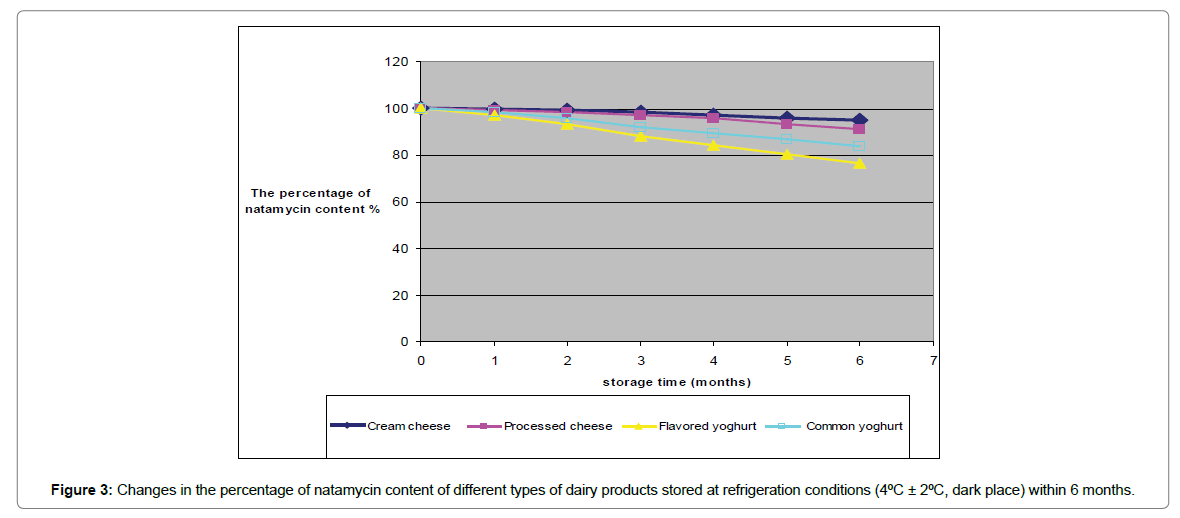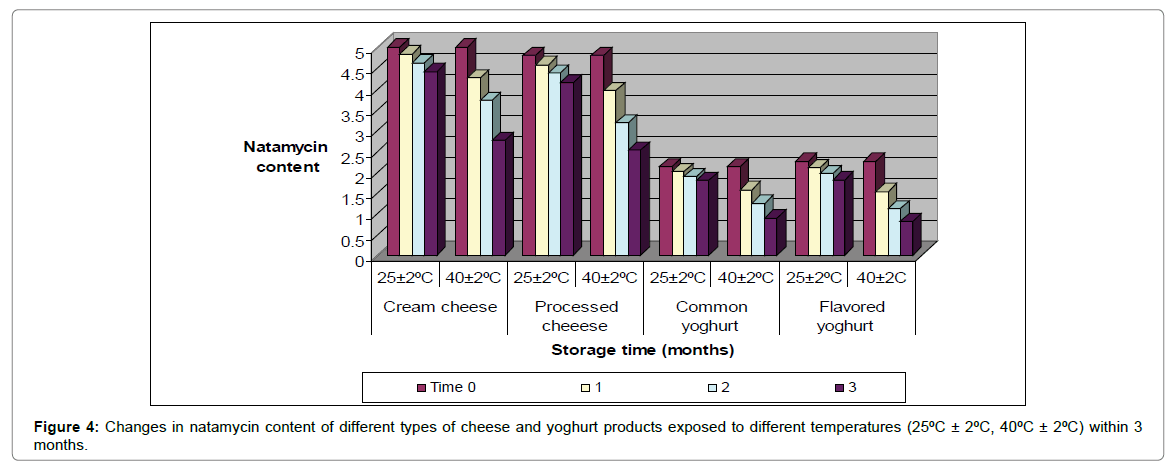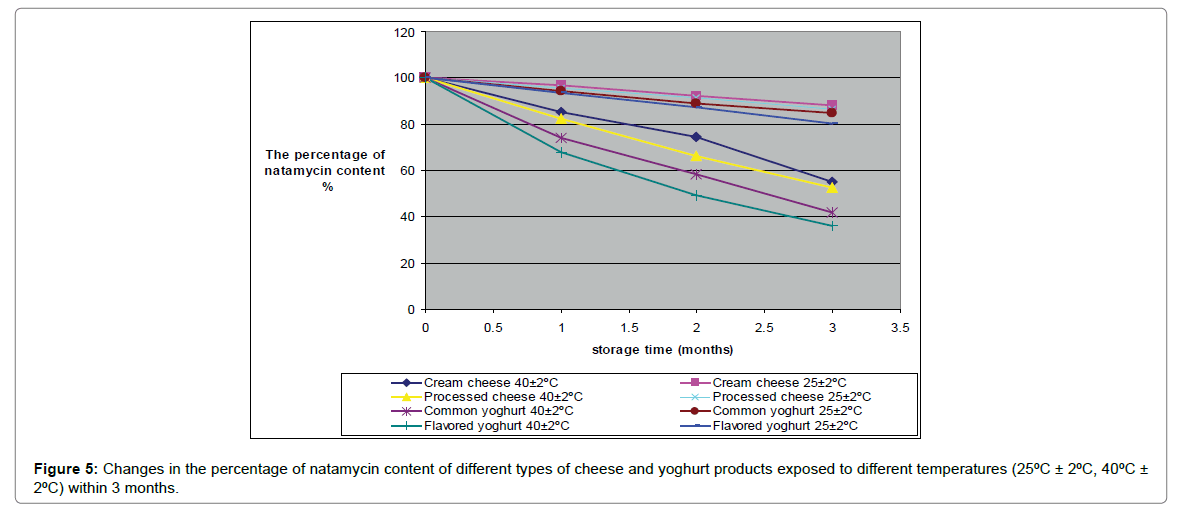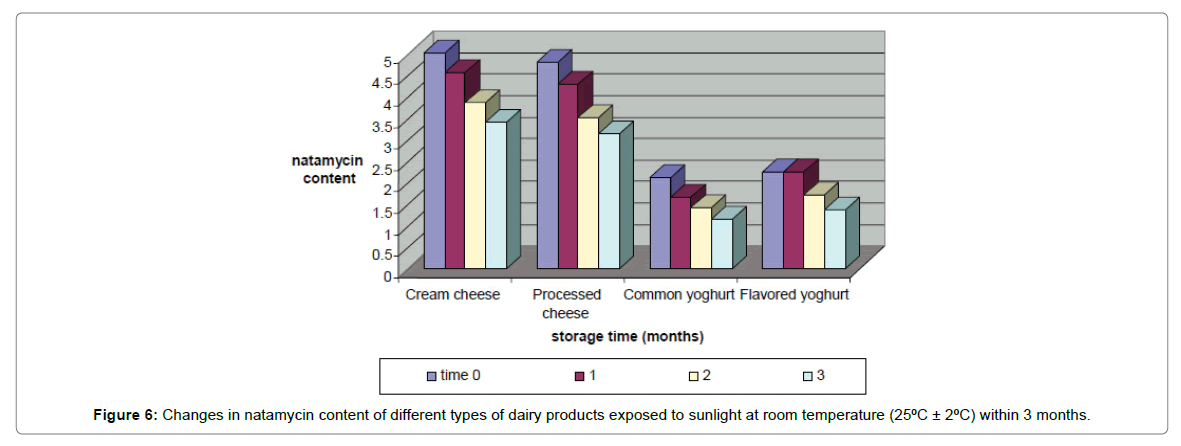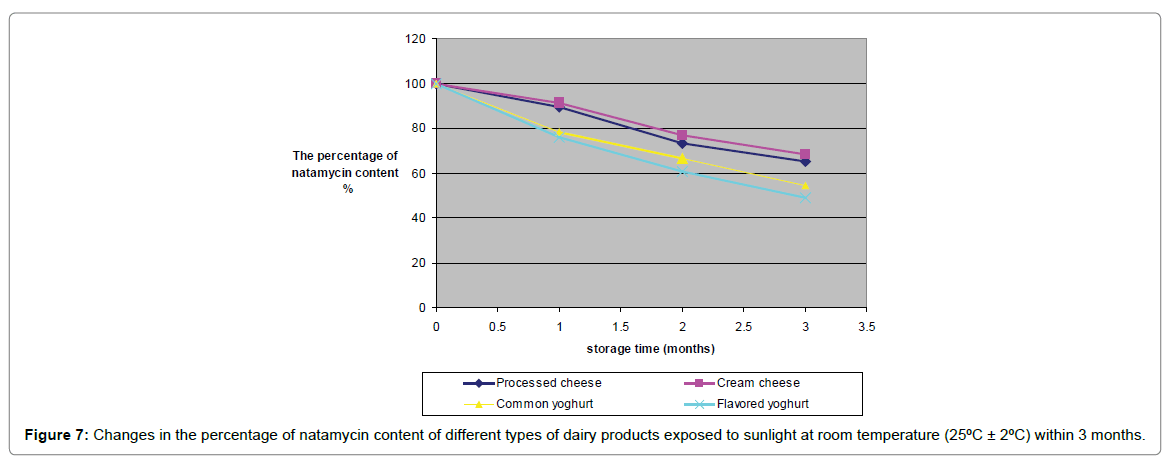Research Article Open Access
Study of Storage Conditions Effect (Light-Heat) on Natamycin Co ntent and Stability in Some Dairy Products (Cheese-Yoghurt)
Al-Haj Saeed Nihad* and Maysam Salami
Department of Food Control and Analytical Chemistry, Faculty of Pharmacy, Damascus University, Al-Mazzeh Street, Damascus, Syria
- *Corresponding Author:
- Al-Haj Saeed Nihad
Department of Food Control and Analytical Chemistry
Faculty of Pharmacy
Damascus University
Al-Mazzeh Street, Damascus, Syria
E-mail: nihadhajsaeed@gmail.com
Received Date: September 20, 2017; Accepted Date: September 26, 2017; Published Date: September 30, 2017
Citation: Nihad AHS, Salami M (2017) Study of Storage Conditions Effect (Light-Heat) on Natamycin Content and Stability in Some Dairy Products (Cheese-Yoghurt). Clin Pharmacol Biopharm 6:177. doi: 10.4172/2167-065X.1000177
Copyright: © 2017 Nihad AHS, et al. This is an open-access article distributed under the terms of the Creative Commons Attribution License, which permits unrestricted use, distribution, and reproduction in any medium, provided the original author and source are credited.
Visit for more related articles at Clinical Pharmacology & Biopharmaceutics
Abstract
The study aims to determine changes of Natamycin content in some dairy products (cheese-yoghurt) from different local companies in refrigeration conditions (4ºC ± 2ºC) or different temperatures (25ºC ± 2ºC , 40ºC ± 2ºC) and during exposure to sunlight at room temperature (25ºC ± 2ºC) using ultraviolet spectrophotometer method. This study was based on the collection of samples at the same day (the same type from the same batch) and used to study the effect of temperature and light on natamycin content in these pervious products. Results of analysis showed that exposure to sunlight and different temperature conditions significantly affected the stability of natamycin. A significant negative correlation exists between natamycin and storage time. Natamycin content was more stable in cheese and yoghurt products when stored under refrigeration conditions (4ºC ± 2ºC) in a dark place. A little significant effect on natamycin content during exposure to room temperature (25ºC ± 2ºC) without exposure to sunlight. A more significant effect on natamycin content was found during exposure to high temperatures (40ºC ± 2ºC) compared to effect of sunlight at 25ºC ± 2ºC. These results showed that dairy products containing natamycin should be kept away from sunlight and high temperatures.
Keywords
Ultraviolet; Spectrophotometer; Natamycin; Stability; Refrigeration conditions; Sunlight; Temperature; Cheese; Yoghurt
Introduction
Foods are prone to microbiological deterioration throughout storage and distribution. Addition of antimicrobial agents can extend the shelf-life and safety of fresh and packaged foods, by reducing or even preventing the growth of pathogenicand spoilage microorganisms [1]. Consumers demand for more natural ingredients in processed foods is a result of a requirement for more healthy and safe foods. As a consequence, the demand for natural food ingredients has increased and the use of natural antimicrobial compounds from a wide variety of sources has been widely investigated [2]. Natamycin is a natural antimitotic polyene characterized by the presence of a large macro cyclic lactone ring containing a series of conjugated double bonds and one or more sugar residues [3] Natamycin has an empirical formula of C33H47NO13 and a molecular weight of 665.75 [4]. It is produced by Streptomyces natalensis and is commonly employed in dairy-based food products to prevent yeasts and moulds contamination [5]. It has been approved as a food additive in over 40 countries and has been considered as a Generally Recognized. As Safe (GRAS) product by Food and Drug Administration (FDA) [6] and also indicated as a natural preservative by the European Union (EU). Natamycin (Pimaricin) (Figure 1), a polyene macrolide antibiotic, is a potent antifungal compound that can effectively prevent the growth of yeasts and inhibit aflatoxine formation in molds [7]. Natamycin is widely used in the food industry as a natural food preservative for the prevention of mold contamination of beverage, cheese, fruits and other no sterile foods (i.e., cured meats, sausages) [8,9]. The activity of natamycin against yeasts and molds, but no bacteria, makes it convenient for use in foods that undergo a ripening period after processing. Its low solubility in water and most organic solvents makes it suitable for the surface treatment of foods [10].
Figure 1: Chemical structure of natamycin [7].
The stability of natamycin is affected by extreme pH values, light, heat, oxidants, chlorine, and heavy metals [11]. It is greatly dependent upon the stability of the tetraene chromophore of the molecule. Inactivation of natamycin in solution occurring by heat, light, or oxidation always begins with the cleaving of these four conjugated double bonds. Solutions of natamycin are quite stable at pH values between 5.0 and 9.0 when stored in the dark. Aqueous suspensions of natamycin are more stable than aqueous solutions [12]. Storage of the dry powder at room temperature for several years only resulted in a few percent loss of activity. In its trihydrate form, natamycin is a stable compound when it is protected from light and moisture [13].
Natamycin in aqueous solutions at temperatures below 100ºC exhibits strong biological stability. However, the exposure to 121ºC results in the reduction of biological stability of natamycin solution. Neutral aqueous suspensions of natamycin can tolerate a temperature of 50°C for several days with only a slight decrease in activity [14]. Natamycin efficacy appears to be improved at refrigerated temperatures that allow the slow growth of yeast. The stability of natamycin is also enhanced under refrigeration [15]. Oxidation of natamycin proceeds more readily at higher temperatures. Oxidation was prevented by ascorbic acid, hydroquinone, and Gallic acid [16]. The antimitotic activity of natamycin is rapidly destroyed when exposed to chemical oxidants, such as peroxides, organic acid anhydrides, perchlorates, persulfates, permanganates, iodates, bromates, hypochlorite’s, and sulphites [17]. Several metal ions, especially Fe (III), Ni(II), and Cr(III), promote oxidative inactivation of natamycin. The addition of complexing agents, such as EDTA or polyphosphates, can prevent this metal promoted oxidation [18]. The polyene macrolide antibiotics are very light sensitive antimitotic substances [19]. Photolytic oxidation clearly poses a problem in the handling and storage of the polyene antibiotics [20]. The photolysis of natamycin is a very rapid upon light exposure to a xenon lamp with a spectrum similar to that of natural sunlight [21].
The objective of this study was to estimate the stability and changes of natamycin content in cheese and yoghurt products during exposure to different storage conditions (light - heat) by ultraviolet spectrophotometer method which it was previously suggested by International Dairy Federation (IDF) [22] as a simple, sensitive, inexpensive and non-consuming time.
Materials and Methods
Equipment’s and instrumentals
UV-Spectrophotometer (OPTIZEN POP) - Lambda-2 with matched 1 cm quartz absorption cells connected to a computer equipped with PECSS software suitable for recording UV-visible spectra between 200 and 800 nm.
• Analytical Balance from Shimadzu A*200
• Magnetic stirrer (Snijders NO 34532)
Reagents
All reagents were analytical reagent grade. Methanol (high pure 99.6%) purchased from Panreac (Germany), Glacial acetic acid (high pure 99.5%) purchased from SCP (England), Deionized water.
Collection of samples
Dairy products used for this research work were obtained from different sources of local companies. Two types of cheese (processed - cream) from M company and two types of yogurt (common-flavored) from HS Company. All the samples were collected at the same day (the same type from the same batch) and used to study the effect of temperature and light on natamycin content in cheese and yoghurt products.
Effect of Temperature
Fourteen closed containers of two types of cheese (processedcream) and 14 closed containers of two types of yoghurt (commonflavoured) were maintained in refrigeration conditions (at 4ºC ± 2ºC in a dark place) within six months according to expiry date at monthly intervals.
Thirty two closed containers of two types of cheese (processedcream) and two types of yoghurt (common-flavored) were maintained at varying temperature conditions (25ºC ± 2ºC , 40ºC ± 2ºC) without exposure to sunlight within three months at monthly intervals.
Effect of light
Sixteen closed containers of two types of cheese (processed-cream) and two types of yoghurt (common-flavored) were maintained at room temperature (25ºC ± 2ºC) exposed to sunlight within three months at monthly intervals.
Sample treatment
An amount of 10 g homogenized yoghurt was weighed in a conical flask and 75 mL of methanol acidified with 0.1% glacial acetic acid was added. Sample was stirred for 90 min in a magnetic stirrer. 25 ml of deionized water was added and placed in the conical flask in the freezer for about 60 min. Cold extract was filtered through a folder filter paper; first filtrate was discarded. Filtrate was warmed at room temperature and filled with methanol acidified with 0.1% glacial acetic acid in 100 ml-volumetric flask. 2 ml of filtrate was taken and put in 100 ml-volumetric flask. The same treatment is applied on cheese samples.
Analytical procedure
Natamycin content in the experimental design above were assayed using UV-Spectrophotometer method at maximum absorption wavelength 303 nm. All determinations were done in triplicates.
Results and Discussions
Table 1 Changes in natamycin content and the percentage of natamycin content of different types of cheese and yoghurt products stored at refrigeration conditions (4ºC ± 2ºC, dark place) within 6 months.
| Natamycin content of different types of dairy products (mg/400 g) for cheese and (ml/250 ml) for yoghurt | The percentage of natamycin content of different types of dairy products (mg/400 g) for cheese and (ml/250 ml) for yoghurt | |||||||
|---|---|---|---|---|---|---|---|---|
| Storage time (months) | Processed | Cream | Common | Flavored | Processed | Cream | Common | Flavored |
| 0 | 4.8 | 5 | 2.12 | 2.25 | 100 | 100 | 100 | 100 |
| 1 | 4.76 | 4.98 | 2.09 | 2.19 | 99.2 | 99.86 | 98.65 | 97.22 |
| 2 | 4.73 | 4.96 | 2.04 | 2.09 | 98.66 | 99.21 | 95.92 | 93.15 |
| 3 | 4.67 | 4.92 | 1.95 | 1.98 | 97.35 | 98.35 | 92 | 88.35 |
| 4 | 4.6 | 4.86 | 1.9 | 1.9 | 95.81 | 97.17 | 89.52 | 84.5 |
| 5 | 4.48 | 4.79 | 1.84 | 1.81 | 93.44 | 95.98 | 86.81 | 80.33 |
| 6 | 4.36 | 4.74 | 1.78 | 1.72 | 91 | 94.91 | 84 | 76.5 |
Table 1: Changes in natamycin content and the percentage of natamycin content of different types of cheese and yoghurt products stored at refrigeration conditions (4ºC ± 2ºC, dark place) within 6 months.
Stability of natamycin in cheese and yoghurt products under refrigeration conditions is presented in Table 1 and the result is graphically represented in Figures 2 and 3. There was a significant negative correlation between storage time and natamycin content.
The percentage of natamycin content in processed and cream cheese was 91.0% and 94.91% respectively. And the percentage of natamycin content in common and flavored yoghurt was 84% and 76.5% respectively. These results indicated a little influence on the content of natamycin under refrigeration conditions (4ºC ± 2ºC) in a dark place.
Effects of storage temperature on natamycin content of the different sources without exposure directly to sunlight are shown in Table 2 and the result is graphically represented in Figures 4 and 5. The result indicated a rapid loss in natamycin content along the storage time when exposed to high temperatures compared to the room temperature which occur a little influence on natamycin content.
| Natamycin content of different types of cheese and yoghurt products exposed to different temperatures (25ºC ± 2ºC , 40ºC ± 2ºC) within 3 months | ||||||||
|---|---|---|---|---|---|---|---|---|
| Storage time (months) | Processed cheese | Cream cheese | Common yoghurt | Flavored yoghurt | ||||
| 25 ± 2ºC | 40 ± 2ºC | 25 ± 2ºC | 40 ± 2ºC | 25 ± 2ºC | 40 ± 2ºC | 25 ± 2ºC | 40 ± 2ºC | |
| 0 | 4.8 | 4.8 | 5 | 5 | 2.12 | 2.12 | 2.25 | 2.25 |
| 1 | 4.58 | 3.96 | 4.84 | 4.26 | 2.01 | 1.57 | 2.1 | 1.53 |
| 2 | 4.38 | 3.18 | 4.62 | 3.72 | 1.89 | 1.24 | 1.96 | 1.11 |
| 3 | 4.15 | 2.52 | 4.41 | 2.76 | 1.8 | 0.89 | 1.81 | 0.81 |
| The percentage of natamycin content of different types of cheese and yoghurt products exposed to different temperatures (25C+2C , 40C+2C) within 3 months | ||||||||
| Storage time (months) | Processed cheese | Cream cheese | Common yoghurt | Flavored yoghurt | ||||
| 25 ± 2ºC | 40 ± 2ºC | 25 ± 2ºC | 40 ± 2ºC | 40 ± 2ºC | 25 ± 2ºC | 40 ± 2ºC | 25 ± 2ºC | |
| 0 | 100 | 100 | 100 | 100 | 100 | 100 | 100 | 100 |
| 1 | 95.42 | 82.45 | 96.75 | 85.21 | 67.98 | 93.44 | 74 | 94.45 |
| 2 | 91.33 | 66.25 | 92.44 | 74.5 | 49.35 | 87.25 | 58.44 | 89 |
| 3 | 86.5 | 52.44 | 88.25 | 55.15 | 36.2 | 80.35 | 42 | 84.75 |
Table 2: Changes in natamycin content and the percentage of natamycin content of different types of cheese and yoghurt products exposed to different temperatures (25ºC ± 2ºC, 40ºC ± 2ºC) within 3 months.
After 3 months of exposure to room temperature (25ºC ± 2ºC), the percentage of natamycin content in processed cheese decreased to (86.5%). In cream cheese, the percent decreased to (88.25%). In common yoghurt, the percent decreased to (84.75%). In flavored yoghurt, the percent decreased to (80.35%).
After 3 months of exposure to high temperature (40ºC ± 2ºC), the percentage of natamycin content in processed cheese decreased to (52.44%). In cream cheese, the percentage decreased to (55.15%). In common yoghurt, the percent decreased to (42%). In flavored yoghurt, the percent decreased to (36.20%).
By comparing the pervious results, we found a significant effect of temperature on the percentage of natamycin content in cheese and yoghurt products. The temperature increase, the percentage of natamycin content decreased.
Effects of sunlight at room temperature on natamycin content in cheese and yoghourt products is shown in Table 3 and the results are graphically represented in Figures 6 and 7. After 3 months of exposure to sunlight at room temperature (25ºC ± 2ºC), the percentage of natamycin content in processed cheese decreased to (65.0%). In cream cheese, the percent decreased to (68.25%). In common yoghurt, the percent decreased to (54.21%). In flavored yoghurt, the percent decreased to (49.11%).
| Storage time (months) | Natamycin content of different types of dairy products (mg/400 g) for cheese and (ml / 250 ml) for yoghurt | The percentage of natamycin content of different types of dairy products (mg/400 g) for cheese and (ml/250 ml) for yoghurt | ||||||
|---|---|---|---|---|---|---|---|---|
| Processed | Cream | Common | Flavored | Processed | Cream | Common | Flavored | |
| 0 | 4.8 | 5 | 2.12 | 2.25 | 100 | 100 | 100 | 100 |
| 1 | 4.29 | 4.56 | 1.66 | 2.25 | 89.41 | 91.15 | 78 | 75.9 |
| 2 | 3.51 | 3.85 | 1.41 | 1.71 | 73.2 | 77 | 66.56 | 60.56 |
| 3 | 3.12 | 3.41 | 1.15 | 1.36 | 65 | 68.25 | 54.21 | 49.11 |
Table 3: Changes in natamycin content and the percentage of natamycin content of different types of cheese and yoghurt products exposed to sunlight at room temperature (25ºC ± 2ºC) within 3 months.
The results indicated a significant effect of sunlight on the percentage of natamycin content in cheese and yoghurt products. Amore reduction in natamycin content along the storage time when exposed to sunlight compared to products not exposed to sunlight at room temperature (25ºC ± 2ºC).
Conclusions
The results of the analysis showed that exposure to sunlight and temperature conditions significantly affected the stability of natamycin with the storage time. It was observed that natamycin was more stable when stored under refrigeration conditions (4ºC ± 2ºC) in a dark place. It is therefore recommended that refrigeration conditions would be ideal conservation conditions for cheese and yoghurt products containing natamycin. The results also showed that natamycin was relatively stable in cheese and yoghurt samples when stored at room temperature (25ºC ± 2ºC) compared to products exposed to sunlight at room temperature. It is therefore recommended that the room temperature would be also a suitable storage condition for cheese and yoghurt products in shops away from sunlight.
However, it was observed that natamycin was less stable when exposed to high temperature (40ºC ± 2ºC). High temperatures would be a poor storage conditions for cheese and yoghurt products containing natamycin in addition to exposure to sunlight. So, it is therefore recommended that dairy products containing natamycin should be kept in refrigeration conditions in a dark place away from sunlight and high temperatures.
References
- Franssen L, Rumsey T, Krochta J (2004) Whey protein film composition effects on potassium sorbate and natamycin diffusion. J Food Sci 69: 347-350.
- Gould G (2004) Methods of preservation and extension of shelf life. Methods of preservation and extension of shelf life 33: 51- 64.
- Hammond S, Lambert P (2004) Membrane-active antimicrobial agents. In Antibiotics and antimicrobial action. Willey 6: 34-36.
- Brik H (1994) Analytical Profiles of Drug Substances and Excipients. ELSEVIER 23: 399-419.
- Gallo L, Jagus R (2006) Modelling Saccharomyces cerevisiae inactivation by natamycin in liquid cheese whey. Braz J Food Tech 9: 311-316.
- Koontz J, Marcy J, Barbeau W, Duncan S (2003) Stability of natamycin and its cyclodextrin inclusion complexes in aqueous solution. J Agric Food Chem 51: 7111-7114.
- Aparicio JF, Mendes MV, Anton N, Recio E, Martin JF (2004) Polyene macrolide antibiotic biosynthesis. Curr Med Chem 11: 1645-1656.
- Cong F, Zhang Y, Dong W (2007) Use of surface coatings with natamycin to improve the storability of Hami melon at ambient temperature. Postharvest Biol Technol 46: 71-75.
- Delves-Broughton J, Thomas LV, Williams G (2006) Natamycin as an antimitotic preservative on cheese and fermented sausages. Food Aust 58: 19-21.
- De Ruig W (1987) Determination of natamycin in cheese and cheese rind: interlaboratory collaborative study. J Assoc off Anal Chem 70: 949-954.
- Brik H (1976) New high-molecular decomposition products of natamycin (pimaricin) with intact lactone-ring. J Antibiotics 29: 632-637.
- Raab WP (1972) Natamycin (Pimaricin): Its Properties and Possibilities in Medicine. Stuttgart, Germany: Georg Thieme Publishers 1972: 134-136.
- GAO Y, WANG X, LlU Y (2010) Biological stability of natamycin solution. Food Sci 31: 41-44.
- Shirk RJ, Kline EF, Clark WL (1966) The effect of pimaricin in the control of yeast growth in orange juice concentrates. Food Tech 20: 91-93.
- Dekker J, Ark PA (1959) Protection of antibiotic Pimaricin from oxidation and ultraviolet light by chlorophyll in and other compounds. Antibiot Chemother 9: 327-332.
- Clark WL, Shirk RJ, Kline EF (1964) Presented at the 4th International Symposium on Food Microbiology.
- Brik H (1981) Analytical Profiles of Drug Substances. J Pharm Sci 10: 513-561.
- Thoma K, Kbler N (1998) New results in the photostability of antimycotics. The Royal Society of Chemistry 6: 116-133.
- Gutteridge JMC, Thomas AH (1983) Free radical damage to polyene antifungal antibiotics: Changes in biological activity and thiobarbituric acid reactivity. J Appl Biochem 5: 53-58.
- Thoma K, Kubler N (1996) Photodegradation of active ingredients and current methods for its analytical investigation. Pharmazie 51: 919-923.
- De Ruig WG, Van Oostrom JJ, Leenheer K (1987) Spectrometric and liquid chromatographic determination of natamycin in cheese and cheese rind: J Assoc Off Anal Chem 70: 944-948.
Relevant Topics
- Applied Biopharmaceutics
- Biomarker Discovery
- Biopharmaceuticals Manufacturing and Industry
- Biopharmaceuticals Process Validation
- Biopharmaceutics and Drug Disposition
- Clinical Drug Trials
- Clinical Pharmacists
- Clinical Pharmacology
- Clinical Research Studies
- Clinical Trials Databases
- DMPK (Drug Metabolism and Pharmacokinetics)
- Medical Trails/ Drug Medical Trails
- Methods in Clinical Pharmacology
- Pharmacoeconomics
- Pharmacogenomics
- Pharmacokinetic-Pharmacodynamic (PK-PD) Modeling
- Precision Medicine
- Preclinical safety evaluation of biopharmaceuticals
- Psychopharmacology
Recommended Journals
Article Tools
Article Usage
- Total views: 5558
- [From(publication date):
September-2017 - Aug 28, 2025] - Breakdown by view type
- HTML page views : 4546
- PDF downloads : 1012

